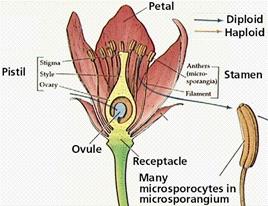Reproduction in Plants - Solutions
CBSE Class–VII Science
NCERT Solutions
CHAPTER-12
REPRODUCTION IN PLANTS
Question 1. Fill in the blanks:
(a) Production of new individuals from the vegetative part of parent is called -------.
(b) A flower may have either male or female reproductive parts. Such flower is called ---------.
(c) The transfer of pollen grains from the anther to stigma of the same or of another flower of the same kind is known as -----------------.
(d) The fusion of male and female gametes is termed as -----------------.
(e) Seed dispersal takes place by means of ------------ and -------------.
Answer: Fill in the blanks:
(a) Production of new individuals from the vegetative part of parent is called vegetative propagation.
(b) A flower may have either male or female reproductive parts. Such flower is called unisexual flowers.
(c) The transfer of pollen grains from the anther to stigma of the same or of another flower of the same kind is known as pollination.
(d) The fusion of male and female gametes is termed as fertilisation.
(e) Seed dispersal takes place by means of wind, water and animals.
Question 2. Describe the different methods of asexual reproduction. Give examples.
Answer: Various methods of asexual reproduction are:
a. Vegetative propagation- In this method new plants are developed from root, stem or leaf of plant.
b. Budding – Here, small bulb-like projection coming out from, yeast cell is called bud, gradually grows and gets detached from parent body to form new organism. Ex- hydra, yeast.
c. Fragmentation- In favorable condition, plant body breaks into two or more fragments which grow into independent plant.
d. Spore formation – The fungi on bread pieces grow from spores which are present in air. Spores germinate when come in contact of moisture.
Question 3. Explain what you understand by sexual reproduction.
Answer: The mode of reproduction in which male and female gamete fuse together to form a zygote. Zygote divides further to form new organism. Male and female gamete may be of same kind or different kind. Sexual reproduction is common in multicellular organism and unicellular organism in unfavorable condition.
Question 4.State the main difference between asexual and sexual reproduction.
Answer:
| Sexual Reproduction | Asexual Reproduction |
| New plants are obtained from seeds. | Plants can give rise to new plants without seeds. |
| Two parents are required to produce an individual. | The new individual comes from a single parent. |
| Takes place with the help of specialized sex cells. | No sex cells are required. |
| New individual has the characters of both the parents. | Characters of the new individual are same as that of the parent. |
Question 5. Sketch the reproductive parts of flower.
Answer:
Question 6. Explain the difference between self-pollination and cross-pollination.
Answer:
| Self - Pollination | Cross - Pollination |
| Pollen of a flower reaches to the stigma of same flower | The transfer of pollen grains from the anthers of a flower to the stigma of another flower on a different plant of the same species |
| No pollinating agent is required | Pollinating agent like wind, air or insects are required |
| Occurs only in bisexual flowers | Occurs in unisexual flower |
| It does not lead to genetic variation in the progeny | It leads to genetic variation in the progeny |
Question 7. How does the process of fertilisation take place in flowers?
Answer: The male and female gametes fuse together to form zygote. The process of fusion of male and female gamete is called fertilization. The zygote undergo to mitotic division to form embryo.
Question 8. Describe the various ways by which seeds are dispersed.
Answer: Dispersal of seed takes place by various means such as wind, water, insects, animals and birds. The seeds dispersed by wind are light and smaller in size. So, that it may be carried by wind easily. The water dispersed seeds are generally floating in nature. Spiny seeds with hooks are generally carried by animal’s body. The birds disperse the seed to faraway places by eating fruit, they excrete with digesting the seeds.
Question 9. Match items in Column I with those in Column II:
Column I | Column II |
(a) Bud | (i) Maple |
(b) Eyes | (ii) Spirogyra |
(c) Fragmentation | (iii) Yeast |
(d) Wings | (iv) Bread mould |
(e) Spores | (v) Potato |
| (vi) Rose |
Answer: (a) (iii) (b) (v) (c) (ii) (d) (i) (e) (iv)
Question 10. Tick ( ) the correct answer:
(a) The reproductive part of a plant is the
(i) Leaf
(ii) Stem
(iii) Root
(iv) Flower
(b) The process of fusion of the male and female gametes is called
(i) Fertilisation
(ii) Pollination
(iii) Reproduction
(iv) Seed formation
(c) Mature ovary forms the
(i) Seed
(ii) Stamen
(iii) Pistil
(iv) Fruit
(d) A spore producing plant is
(i) Rose
(ii) Bread mould
(iii) Potato
(iv) Ginger
(e) Bryophyllum can reproduce by its
(i) Stem
(ii) Leaves
(iii) Roots
(iv) Flower
Answer: (a) (iv) flower.
(b) (i) fertilisation.
(c) (iv) fruit.
(d) (iii) bread mould.
(e) (ii) leaves.
